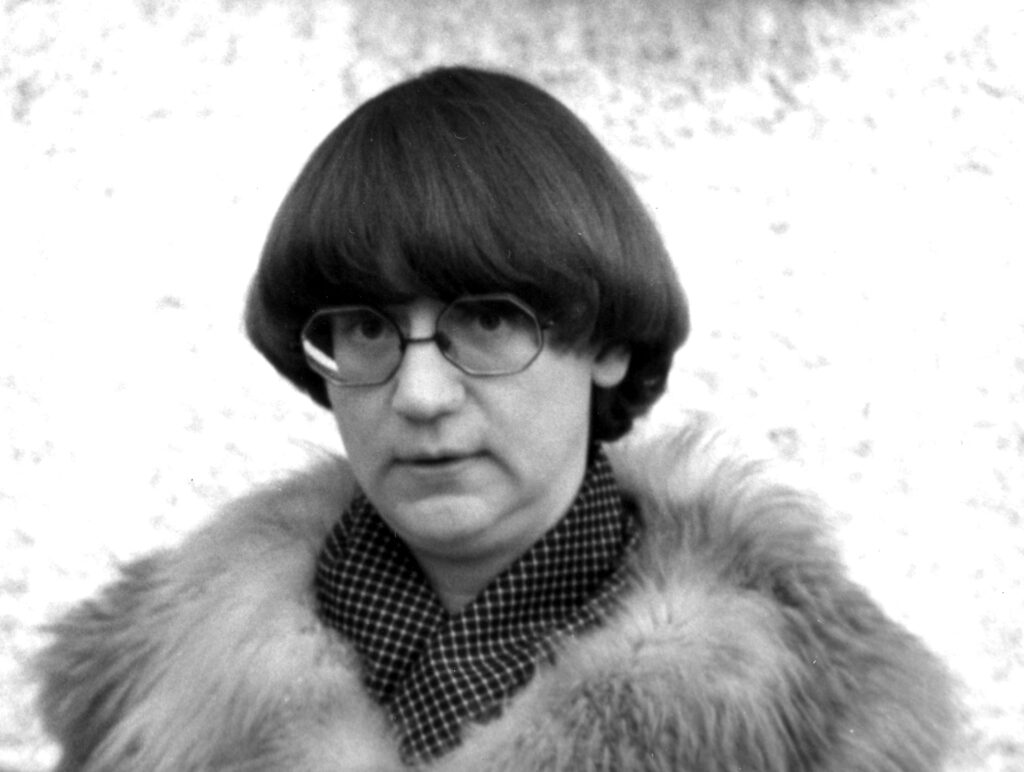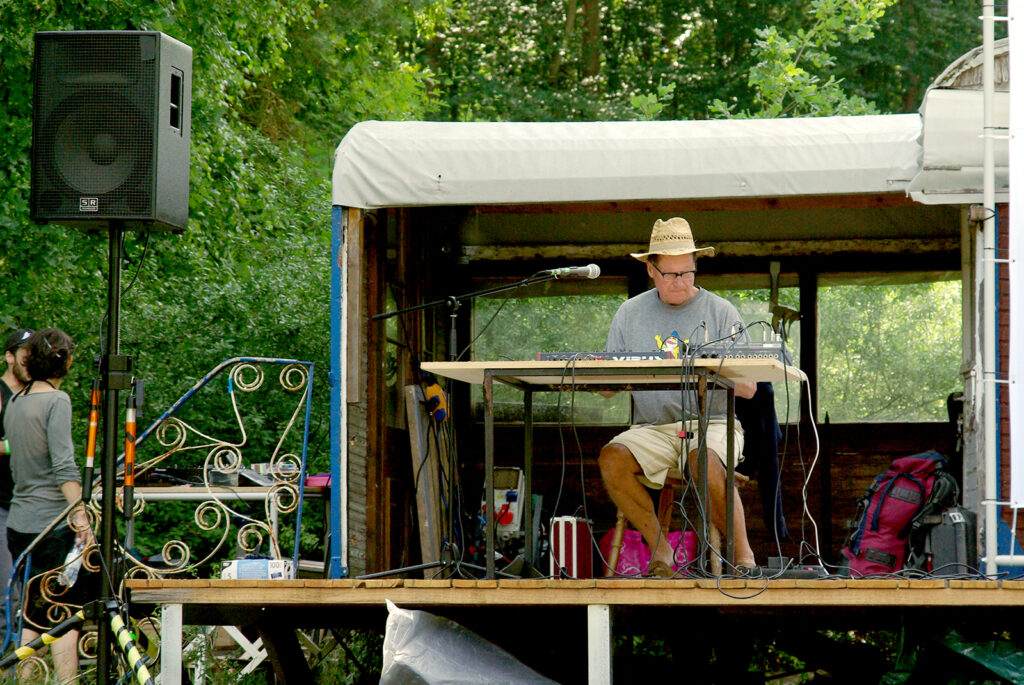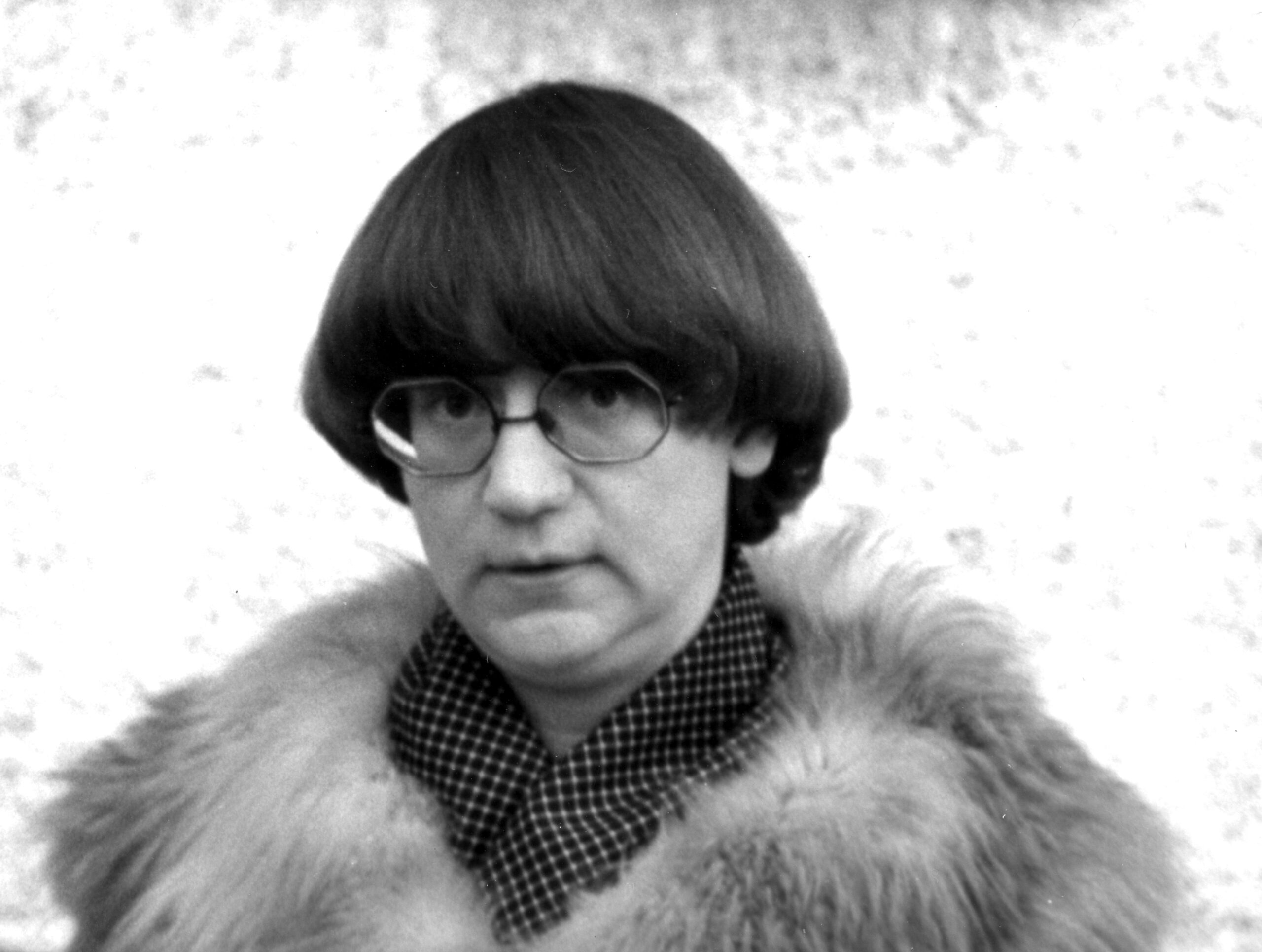aufabwegen was invited to curate two nights at KLANGZEIT in Münster for the theme of „Exit“. The first night on 24.09.2021 presents three different artistic positions – Jan Jelinek presents the life and work of the mysterious composer Ursula Bogner, Ditterich von Euler-Donnersperg plays fragmented electronic music and Ana Fosca immerses the audience in her deep-bass wall of noise.
The concerts start at 21.30h and takes place at
Theater im Pumpenhaus
Gartenstr. 123
48147 Münster
Tickets are available online here:
https://www.localticketing.de/events/29491-klangzeit-munster-2021

Jan Jelinek plays Ursula Bogner
(1946 – 1994) German pharmacist, artist and musician, she attended courses with Herbert Eimert, founder of the Studio für elektronische Musik in Köln at the WDR, became interested in these new sounds and recorded synthesizer musics privately for many years. Long after, Jan Jelinek met her son by chance and learned about his mother’s hobby, finally publishing a compilation of music from the scarcely marked reel-to-reel tapes and HiFi-cassettes.
In the late 1960s, Ursula Bogner started to record her own music on reel-to-reel tapes. With some of these titles, we only found individual tracks of pieces recorded on a four-track-recorder – in these cases, I had to recombine the separate tracks to recreate the original piece. Unfortunately, I could not involve Ursula Bogner in the mixing process as she passed away in 1994. Invoking the original’s authenticity might seem insensitive, yet there was no other way to release them in their entirety. Ultimately, only three of the tracks featured on this CD/LP are such ‘reworkings’. All other titles were taken straight from the original reels. Covering a fairly short period of her creative career, they also convey a peculiar coherence in both form and content. A coherence that reflects her accessible, rhythmic and sometimes even ‘poppy’ side. Naturally, my own preference played a part in the selection process. All my personal favourites made it on the CD/LP, and whenever I listen to this collection, I invariably succumb to the titles’ light-hearted nonchalance. This might leave many hours of undiscovered gems, but a further compilation is already in the works.
My thanks go out to the Bogner family, especially Sebastian Bogner, who was generous enough to grant me access to the reels and supply me with invaluable insights into his mother’s life. I hope that listeners will enjoy the same exhilaration I experienced on discovery of Ursula Bogner’s music.
Jan Jelinek
It seems almost incredible that Ursula Bogner’s musical talents should have remained undiscovered until now. Yet in view of her biography, this might have been just as inevitable.
It was on a flight to Vilnius that I met Sebastian Bogner, Ursula’s son, who told me he was on a business trip for a pharmaceutical company. The usual small talk soon led to the topic of his mother Ursula, who also ‘liked to play around with synthesizers’, albeit purely on an amateur level and in a dedicated music room fitted especially for this purpose in the parental home. Among her acquaintances, it was simply considered one of her many eccentric hobbies and not paid a great deal of interest. At a cursory glance, Ursula Bogner’s life seemed simple and bourgeois to the core: a pharmacist, wife and mother, firmly ensconced in a detached house. A setup that made her obsession with electronic music all the more bizarre, an obsession that drove her to build her own studio for extensive recording and experimentation.
According to the usual chronological benchmarks, Ursula Bogner’s biography appears short and conventional: Born (*1946) and raised in Dortmund, she moved to Berlin at 19 to study pharmacy. Degree in hand, she immediately went to work for pharmaceutical giant Schering, followed by marriage, children and a successful yet by no means sensational scientific career within the multinational heavyweight. At the same time, she developed a keen interest in electronic music. Throughout her early twenties, she followed the activities of Cologne-based ‘Studio für elektronische Musik’, attended seminars by Studio founder Herbert Eimert, exhibited great enthusiasm for Musique Concrète and, later on, shared her children’s enthusiasm for British New Wave Pop. Nevertheless, Ursula Bogner never involved herself in any scene, never made her music public. Maybe this can be attributed to her boundless curiosity. Besides composition, she also tried her hand at painting, printing (the booklet features reproductions of two of her linocuts) and developed a strong fascination for Wilhelm Reich’s ‘orgonomy’, the sexual researcher and psychoanalyst’s bizarre late work on his discovery of ‘orgonenergy’. Reich aimed to focus resp. collect this particular type of solar energy and use it for healing purposes. To this end, he created an apparatus, a cabin of wood and metal otherwise known as an ‘orgon accumulator’ (see image). Inspired by several trips to ‘Orgonon’ (Maine, USA) – Wilhelm Reich’s former workspace and home – Ursula Bogner decided to construct her own accumulator and stored it in the family’s backyard. At this point, it becomes increasingly hard to shake the suspicion, later confirmed by Sebastian Bogner, that his mother was drawn to all things esoteric. Mounds of New Age literature and fringe science works would litter the Bogner household. And yet, throughout all this, she remained a Schering employee and thus firmly rooted in the sciences. Her compositions, too, betray few signs of esotericism, in fact they are closer to studies and sketches: humorous and – in view of her biography – almost silly rather than tied to any particular school of mysticism or science. Nevertheless, it is remarkably hard to grasp or classify her work as a whole. Over the course of 20 years, she dabbled in many different styles leading to a huge wealth of work and a bewildering variety of titles.
In the late 1960s, Ursula Bogner started to record her own music on reel-to-reel tapes. With some of these titles, we only found individual tracks of pieces recorded on a four-track-recorder – in these cases, I had to recombine the separate tracks to recreate the original piece. Unfortunately, I could not involve Ursula Bogner in the mixing process as she passed away in 1994. Invoking the original’s authenticity might seem insensitive, yet there was no other way to release them in their entirety. Ultimately, only three of the tracks featured on this CD/LP are such ‘reworkings’. All other titles were taken straight from the original reels. Covering a fairly short period of her creative career, they also convey a peculiar coherence in both form and content. A coherence that reflects her accessible, rhythmic and sometimes even ‘poppy’ side. Naturally, my own preference played a part in the selection process. All my personal favourites made it on the CD/LP, and whenever I listen to this collection, I invariably succumb to the titles’ light-hearted nonchalance. This might leave many hours of undiscovered gems, but a further compilation is already in the works.
My thanks go out to the Bogner family, especially Sebastian Bogner, who was generous enough to grant me access to the reels and supply me with invaluable insights into his mother’s life. I hope that listeners will enjoy the same exhilaration I experienced on discovery of Ursula Bogner’s music.
Jan Jelinek

Seit 1996 veröffentlicht Rehberg auf Walter Ulbricht Schallfolien unter dem Künstlernamen Ditterich von Euler-Donnersperg jährlich ein neues Heft seiner „Pelzwurstlieder“ (Reimdichtung im Geiste Klopstocks, mit elektronischem Zuspielband) unter Beigabe einer Picture-Single sowie in unregelmäßiger Folge weitere Tonträger. Zudem existiert unter diesem Künstlernamen eine Split-LP mit Kommissar Hjuler auf dem Label Psych.KG, Euskirchen.
Unter gleichem Pseudonym erfolgten auch Veröffentlichungen in diversen einschlägigen Musikmagazinen, wie z. B. als Autor des Hamburger Independent-Magazins Odradek, das sich in unregelmäßigen Abständen mit der Erforschung und Dokumentierung elektroakustischer, experimenteller, elektronischer Musik befasst. 2015 drehte Rehberg als von Euler-Donnersperg den Spielfilm Sieg der Vernunft, eine Satire auf politische Propaganda.
Ein grauer Knurrhahn und Grummelsack, der eine Schule für Honiggewinnung und Schnittblumenzucht in Alt Wrietzen im Oderbruch betreibt. Steht neben Dr. Kurt Euler, dem Vorsitzenden der Parteikommission für Volksbildung und Kulturkampf beim ZK der Kommunistischen Einheitspartei Deutschlands (KED) in dem (ungerechtfertigten?) Ruf eines im Geiste Johann Gotthilf KLOPSTOCKs, des Lehrers einer irrenden Menschheit, wirkenden, sinnenfrohen Zuchtmeisters fehlgeleiteter junger, mitunter auch alter Menschen, welche in hemmungslosen Daseinsirrtümern schwelgen und ihr Leben von dessen Ende her betrachten. Tritt seit dem Rübenwinter 1946/47 als Sachwalter des Werkbundes und des traditionsreichen Tonverlages Walter Ulbricht Schallfolien unbedingt gegen Wirrnis und verstocktes, kleinbürgerliches Schwarzsehertum auf und betreibt unter den Leitgedanken Verdunkeln! Der Feind sieht dein Licht! Beginne den Tag mit Sterben! Das „Scheitern als schöne Kunst“.
Im Jahre 1980 gründete Euler-Donnersperg die WALTER ULBRICHT SCHALLFOLIEN Hamburg, welche sich im Geiste Walter Ulbrichts, des damals meistgehaßten Menschen der Erde, des Erbauers des Berliner Antifaschistischen Schutzwalls, unbedingt der Langsamkeit verpflichtet fühlen und unter dem Leitwort NEU KONSERVATIW die ehernen Werte des klassischen „Industrials“ zu pflegen bestrebt sind (vgl. SPK: The Cathedral of Death – Die Kultur der Todesverdrängung). Bis Ende der 80er Jahre des 20. Jahrhunderts veranstaltete Euler-Donnersperg zahlreiche Auftritte mit geistverwandten Klanggestaltern, u. a. mit Illusion of Safety, Jim O’Rourke, The Hafler Trio, Bourbonese Qualk, Nocturnal Emissions, Whitehouse, Gerechtigkeitsliga, The Legendary Pink Dots, Laibach, Asmus Tietchens. Gleichzeitig geben die Walter Ulbricht Schallfolien Dokumente der Gruppen SPK, Throbbing Gristle, Laibach, John Watermann, Asmus Tietchens, The Hafler Trio, Werkbund, Mechthild von Leusch, Column One, Evapori und Hyph heraus. Im Nebenamt Sachwalter des WERKBUNDES tritt Euler-Donnersperg mit Lesungen und Klangschöpfungen eigener Werke hervor – unter anderem mit Michael von Hausswolff, Leif Ellgren, Kent Tankred, The Hafler Trio, Asmus Tietchens, Dan Burke, Organum, John Duncan. Seit 1996 jährliche Herausgabe eine Heftes der Pelzwurstlieder, Bildschallplatte im handgestalteten Portfolio, Reimdichtungen im Geiste Klopstocks mit elektronischem Zuspielband: Zustandsbeschreibung der Welt mit den Augen der Listspinne, der Trugnatter, der Assel, der Klappnase, des Stachlers.

The steady ascent of ANA FOSCA, the moniker of Copenhagen’s Linn Hvid, is unmistakable in its rousing articulation of experimental music’s most visceral and noisy frontiers.
Hvid’s initial forays saw her navigating arts institutions that run adjacent to, though remain relatively disconnected from, the rich underground of the city’s music scenes. It’s Mayhem in particular—the infamous venue with its indispensable studio spaces for a plethora of local bands and musicians—where Hvid first found herself in a community of kindred spirits and artists. Playing early shows in and around the noise circle in this fertile environment, and long a devotee of Mayhem Noise Fest, she was soon performing regularly across Denmark, Sweden, and Germany in the crucible of self-organised venues and squatted premises. Having forged ANA FOSCA in these heady circumstances, Hvid’s performances and recordings are imbued with an intuitive immediacy that’s rarely summoned so naturally.
ANA FOSCA is best captured by the novel labels that pirouette around the idea of noise as genre—yet this remains a trap. Whether we describe Hvid’s work as death industrial, dark ambient, or even drone, it’s the turbulent pull between introverted and extroverted states that defines her music. Experimentation remains the driver, careening her work into tension with a multitude of sound practices and forms around the scaffolding of electroacoustics.
At once arresting and meditative, the intensity of ANA FOSCA remains delicate in structure. The urgency and shock of her synthesis and compositions can swiftly tumble into whispering grievances and suffocating reflections. Circling themes of sorrow and existential agitation, the terse intimacy of playing loud when playing live is balanced by Hvid’s keen desire to communicate with the audience.
Now a resident at Mayhem, Hvid’s debut album, SOMA, was released on the Russian label Nazlo Records in 2020 and received admirable attention. It was selected by the Helen Scarsdale Agency as one of the best releases of the year, and was acclaimed by the independent experimental music site Ukośnik. Appearing with Sortlegeme at Mayhem Noise Fest 2020/2021, Martin Breidahl selected the performance as one of the best of the year for Passive/Aggressive. Hvid has also recently played collaboratively with Vanity Productions, Posh Isolation’s Christian Stadsgaard. Other appearances include The 48HOURS Festival in Copenhagen, ETER Festival in Lund, Sweden, as well as Berlin’s Autonoma Industriale.
2021 already sees Ana Fosca performing at DNA Festival Kolonia Gdańsk and at LUFF Film Festival Lausanne on a special full-range quadraphonic PA.
